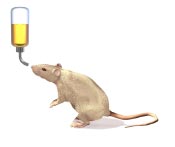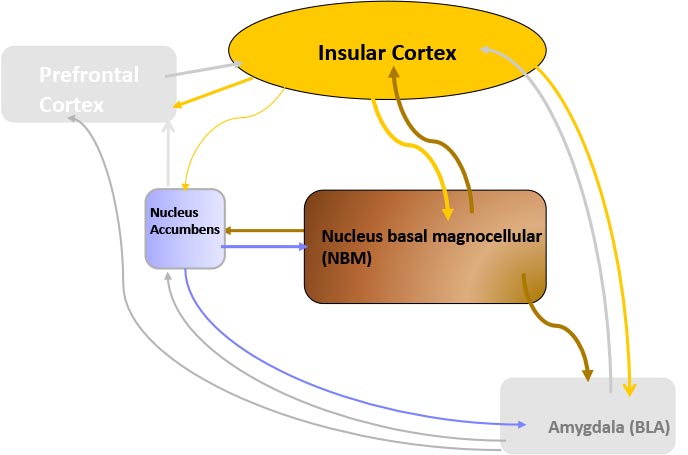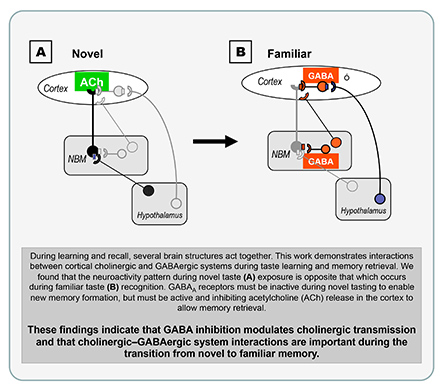
Our research is aimed at gaining knowledge about the mechanisms of chemical communication between brain structures that interact during aversive memory formation, as well as those without an evident emotional component, by using non-associative and associative taste and context learning models and manipulating the different structures involved in forming and retrieving memory. Behavioral, pharmacological and neurochemical findings to date indicate that complex structural and chemical interactions between cortical, basal and limbic areas of the brain occur during the acquisition, consolidation and evocation of memories. These studies are helping to better understand the similarities and differences in how memories of different types and strengths are processed.
Our questions are summarized as: What are the routes and the molecules responsible for encoding the stimuli which will make the memory for a taste, smell or context? How does smell influence the memory of a taste and what are the circuits which comprise these two stimuli during the formation of the taste memory? Are the neurotransmission structures and systems similar during the formation of incidental and aversive memories?
Research
- FORMATION OF AVERSIVE AND INCIDENTAL MEMORIES: CORTICAL, LIMBIC AND BASAL BRAIN INTERACTIONS:

Interaction of the cortical, limbic and basal connections.
Chemical and structural interactions during the formation of the taste memory
1. Recognizing the new and the familiar
2. Recognizing the hedonic value
3. Formation of aversive or incidental (irrelevant) memories
4. Modulation of the aversive association
See more
Taste memory has been a useful model for studying memory formation; using different approaches ranging from lesion studies, analysis of receptor and neurotransmitter activity, and measurement of intracellular signaling mechanisms, it has been possible to describe processes which may be involved in several types of memory. Taste memory includes the recognition of a taste as well as its characteristics related to the hedonic value, degree of familiarity, and the nutritive or toxic properties associated with that taste. In terms of evolutionary adaptation, taste memory is necessary for the proper identification of available nutritive foods and, of course, is essential to avoid deadly toxins.

- 2) NEUROBIOLOGICAL SUBSTRATES OF COMPULSIVE CONSUMPTION: Based on the knowledge that some of the brain structures involved in drug rewards also participate during taste memory formation, we are evaluating the changes induced in behavior, brain structures and their chemical interactions, after chronic sugar consumption. This research seeks to understand the changes induced during long-term appetitive memory after chronic exposure to sugar and the effect during new taste learning and re-learning.
Colaborations
- Dr. Guillaume Ferreira Researcher PhD INRA ; Université de Bordeaux - PRES (Pôle de recherche et d'enseignement supérieur)
- Dr. Mauricio Díaz Muñoz, Dr. Roberto Prado & Dra. Gina Quirarte
- Instituto de Neurobiología, UNAM.
- Dr. José Ramón Eguibar & Dra. Carmen Cortez
- Benemérita Univesidad Autónoma de Puebla (BUAP)
Contact:
LABORATORIO B-14
Instituto de Neurobiología
Universidad Nacional Autónoma de México,
Campus Juriquilla, Qro. Querétaro. México.
Tel: (55)56 23 4039; (442)238 1039.
Fax: (55)56 23 4046; (442)238 1046



